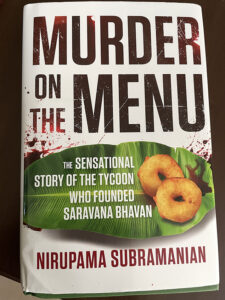Registered with the Registrar of Newspapers for India under R.N.I 53640/91
Vol. XXXI No. 9, August 16-31, 2021
Saravana Bhavan Saga Redux
by Geetha Doctor

Murder on the Menu – The Sensational Story of the Tycoon Who Founded Saravana Bhavan.
Nirupama Subramanian. Juggernaut. (Non-fiction. True Crime) Price. Rs. 499/- Pages 190
“Pour the sambar on the idli, canteen boy! Tra-la-la-lah!
Put the idli on the sambar, canteen boy!”
Ahah! Tra-la-la-lah!
All through the first chapters of Nirupama Subramanian’s racy retelling of the life and times of Chennai’s Dosa King, I could hear this raucous schoolkids’ picnic anthem playing at the back.
Of course, it sounds ruder in Tamil while thumping the sides of a school bus.
It’s what makes Subramanian’s Saravana Bhavan saga so utterly compelling. It’s a story that was played out in full view of the Chennai public. As she describes it, we scrambled to order our dosas and idlis at the innumerable Saravana Bhavans across the city and soon enough the world beyond Chennai. Even as we consumed the equally salacious details of the life story of a man whom everyone called a tycoon, or often enough Anacchi – elder brother – Pitchai Rajagopal, the founder of the Saravana Bhavan group of South Indian restaurants.
* * *
It’s part detective story, part a lesson in entrepreneurship, part investigative journalism, as Subramanian traces the archetypal success story that still remains part of the Pitchai Rajagopal trajectory. She ropes in the other great food court baron of his time, Hotbreads Mahadevan as he is popularly known, to share his own ringside view of Rajagopal’s rise in the steamy world of idli-vada-sambar.
* * *
Here for instance is how M. Mahadevan describes the loyalty that Rajagopal commanded at the height of his fame. “Rajagopal understood that the first capital is the money we put in. The next capital is the people whom you trained and invested in.”
* * *
Subramanian records Rajagopal’s obsession with details. He not only made sure that there was an exacting standard for the procurement of ingredients, he also personally made a round of his establishments to check out the sambhar, the coffee, the level of hygiene that he expected amongst his staff. He paid for the education of the children of his staff and saw to it that they could aspire to a decent standard of living.
This is what makes the second half of Rajagopal’s life so horrendous. It’s on par with an Othello-like descent into a pit of darkness as to be incomprehensible, even in retrospect. He had called his self-adulatory autobiography: “I set my heart on Victory”. He should have named it “I set my heart on Jeevajothi”, the object of his unbridled desire.
Subramanian describes Rajagopal‘s pursuit of a young woman named Jeevajothi, the daughter of one of his employees, when he finds that she had married a young man named Prince Santhakumar, as those of a venomous serpent. The slow-mo. sequences leading to the torture by extortion, by black magic and finally murder, by Rajagopal and his goons reads like a script from one of the more lurid Tamil horror films.
What distinguishes it from just such a scenario is the cool level-headed description that Subramanian manages to impart to her re-construction. While focusing on the personal tragedy of the participants, she is able to suggest the larger societal background of the politics, the police, and the judiciary involved in the saga. It took almost two decades for justice to be pronounced. Subramanian records the names of the Supreme Court bench of justices N.V. Ramana, Mohan M. Shantanagouder and Indira Banerjee as upholding the verdict of life sentence on Rajagopal. Do we add that the honorable Judge N.V. Ramana is now the Chief Justice of India?
No matter how slowly the idli batter is ground, it seems to augur well that we shall still have idly.

